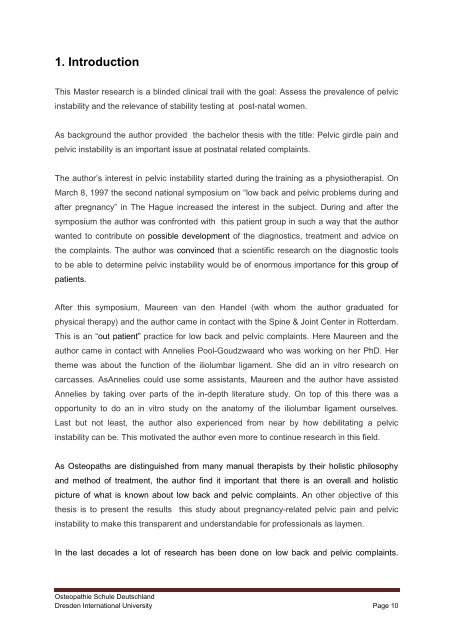Pelvic girdle pain and relevance of ASLR testing: A ... - Cindy Verheul
Pelvic girdle pain and relevance of ASLR testing: A ... - Cindy Verheul
Pelvic girdle pain and relevance of ASLR testing: A ... - Cindy Verheul
Create successful ePaper yourself
Turn your PDF publications into a flip-book with our unique Google optimized e-Paper software.
1. Introduction<br />
This Master research is a blinded clinical trail with the goal: Assess the prevalence <strong>of</strong> pelvic<br />
instability <strong>and</strong> the <strong>relevance</strong> <strong>of</strong> stability <strong>testing</strong> at post-natal women.<br />
As background the author provided the bachelor thesis with the title: <strong>Pelvic</strong> <strong>girdle</strong> <strong>pain</strong> <strong>and</strong><br />
pelvic instability is an important issue at postnatal related complaints.<br />
The author’s interest in pelvic instability started during the training as a physiotherapist. On<br />
March 8, 1997 the second national symposium on “low back <strong>and</strong> pelvic problems during <strong>and</strong><br />
after pregnancy” in The Hague increased the interest in the subject. During <strong>and</strong> after the<br />
symposium the author was confronted with this patient group in such a way that the author<br />
wanted to contribute on possible development <strong>of</strong> the diagnostics, treatment <strong>and</strong> advice on<br />
the complaints. The author was convinced that a scientific research on the diagnostic tools<br />
to be able to determine pelvic instability would be <strong>of</strong> enormous importance for this group <strong>of</strong><br />
patients.<br />
After this symposium, Maureen van den H<strong>and</strong>el (with whom the author graduated for<br />
physical therapy) <strong>and</strong> the author came in contact with the Spine & Joint Center in Rotterdam.<br />
This is an “out patient” practice for low back <strong>and</strong> pelvic complaints. Here Maureen <strong>and</strong> the<br />
author came in contact with Annelies Pool-Goudzwaard who was working on her PhD. Her<br />
theme was about the function <strong>of</strong> the iliolumbar ligament. She did an in vitro research on<br />
carcasses. AsAnnelies could use some assistants, Maureen <strong>and</strong> the author have assisted<br />
Annelies by taking over parts <strong>of</strong> the in-depth literature study. On top <strong>of</strong> this there was a<br />
opportunity to do an in vitro study on the anatomy <strong>of</strong> the iliolumbar ligament ourselves.<br />
Last but not least, the author also experienced from near by how debilitating a pelvic<br />
instability can be. This motivated the author even more to continue research in this field.<br />
As Osteopaths are distinguished from many manual therapists by their holistic philosophy<br />
<strong>and</strong> method <strong>of</strong> treatment, the author find it important that there is an overall <strong>and</strong> holistic<br />
picture <strong>of</strong> what is known about low back <strong>and</strong> pelvic complaints. An other objective <strong>of</strong> this<br />
thesis is to present the results this study about pregnancy-related pelvic <strong>pain</strong> <strong>and</strong> pelvic<br />
instability to make this transparent <strong>and</strong> underst<strong>and</strong>able for pr<strong>of</strong>essionals as laymen.<br />
In the last decades a lot <strong>of</strong> research has been done on low back <strong>and</strong> pelvic complaints.<br />
Osteopathie Schule Deutschl<strong>and</strong><br />
Dresden International University Page 10


